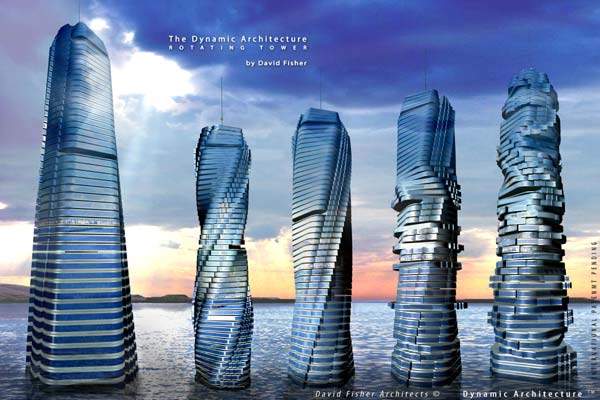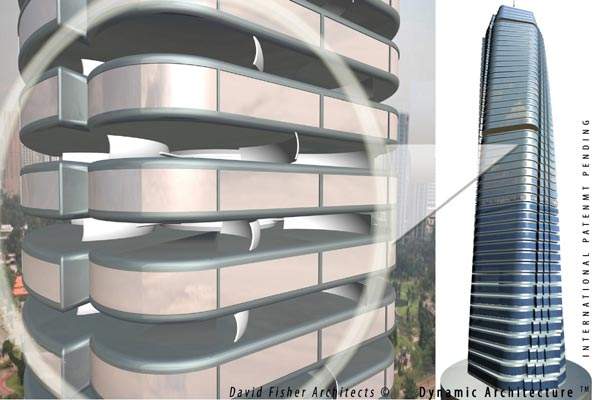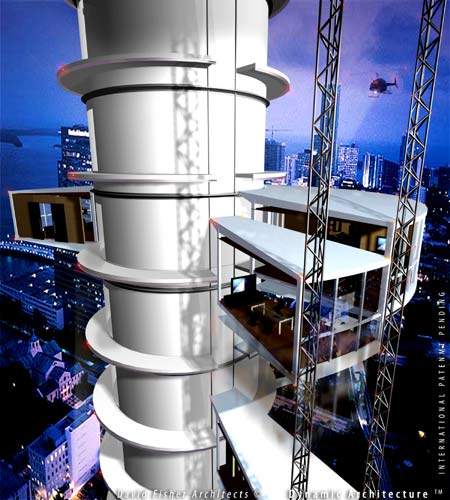The first of Fisher’s ‘dynamic architecture towers’ was slated to start construction by August 2008. It is planned for an as-yet-unspecified location in Dubai.
Science fiction films like The Matrix have conjured cities of the future where machines and biological life are intertwined. But unlike in The Matrix‘s terrifying apocalypse, where humans become life-support systems for machines, the vision of the Italian architect, Dr David Fisher, is of dynamic, ever-changing buildings that function as ‘machines for living’.
Revolutionary turn
Fisher’s rotating skyscrapers move beyond the usual architectural evolution of design in several ways. Not only will Dubai’s be the first rotating tower in the world but it will generate more power than it uses and its parts, aside from the concrete core, will be created in a factory as opposed to being constructed on site.
“My buildings are unique because they are the first that will be dynamic and change shape every moment, first to be built in a factory and the first to be completely self-powered,” Fisher said in a New York press conference on 24 June 2008.
Dubai’s tower – orders are being taken from prospective tenants to move in from 2010 – will have 78 floors that can revolve individually, each adjusted to complete a full 360° of rotation in between one and three hours.
Between each floor a wind turbine is sandwiched horizontally, making for a total of 77 wind turbines in the Dubai tower – using the high winds that often plague skyscrapers in its favour rather than merely shoring up the structure’s resistance to them.
The Rotating Tower, Fisher says, will produce enough energy via its wind turbines and external photovoltaic panels to sell the excess to the city around it. Although the solar panels are only about 15% efficient at best, the Dubai rotating tower’s large surface area means maximum solar exposure.
It has been reported that the turbines may generate 1.2 million kilowatt hours each year in Dubai.
Fisher said plumbing presented perhaps the biggest challenge to the designers due to the building’s rotation. However, the water supply will be delivered mostly normally while relying on an innovative flexible pipe layout for connection on the move.
“For the first time, man will have a building in four dimensions,” Fisher said. “You can have breakfast facing the sunrise and dinner against the sunset without ever moving from the room. And our buildings are so smart that they produce energy for themselves.”
Factory settings
Constructing most of the building in a factory environment for shipping and assembly on site means a 10% cost saving and completion of the entire building in just 20 months, Fisher said.
The methodology used is similar to that used by Boeing and Airbus to manufacture aircraft, he added.
Apartments, storeys, individual rooms and perhaps even furniture will be built at the construction facility at Altimura, near Bari in southern Italy. The factory is ready to go and will be staffed with 600-700 workers, according to Fisher.
Modules delivered to the site will be fitted, kit style, into the concrete core that rises up inside the centre of the tower. Just 90 workers will be required on the actual site compared with the more usual 2,000 or so, said Fisher.
Fisher, who has never designed a skyscraper before, added that he has spent decades working hands-on in all aspects of construction so is confident the plan will work.
“Building in a factory means work of higher quality and a safer construction site,” Fisher said. “And now developers will be able to afford to do custom-made apartments.”
Luxury living
Construction savings aside, the floor space is projected to cost $3,000/m², Fisher said.
The top ten floors will be whole-storey apartments – known as ‘villas’ by the Emirati people – complete with swimming pools and specially designed lifts for residents’ cars – improving security and convenience for the residents, many of whom are expected to hail from Dubai’s ruling family.
“Life is movement. It’s about keeping up with time and changes you can sense,” Fisher mused. “It’s about following the sun from rising to setting.”
Lower floors will be mixed-use, incorporating hotels, retail, leisure and apartments in the manner of standard tower blocks.
A second Dynamic Architecture tower is set to start construction, for assembly in the Russian capital Moscow, by the end of 2008. Enquiries for different versions of the rotating tower are being taken from many other locations, such as New York, Fisher said.






